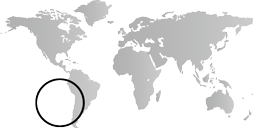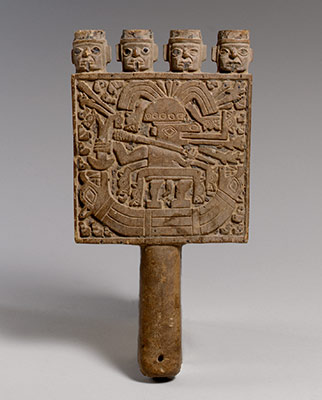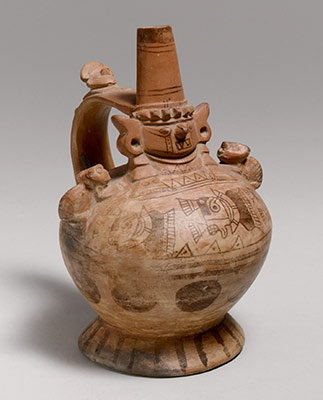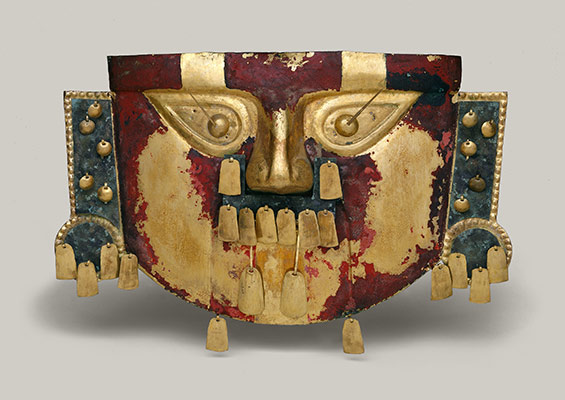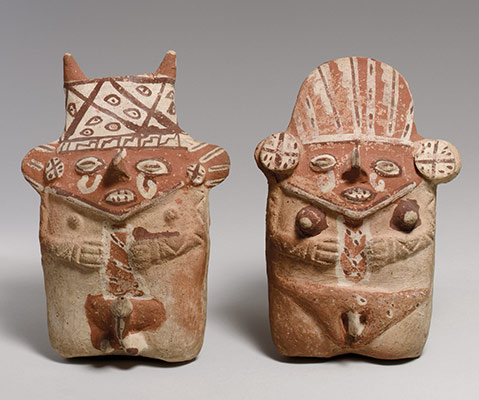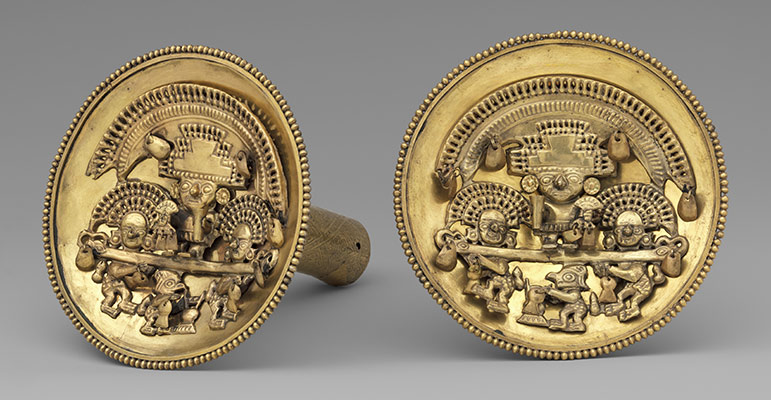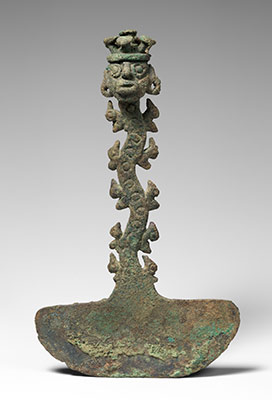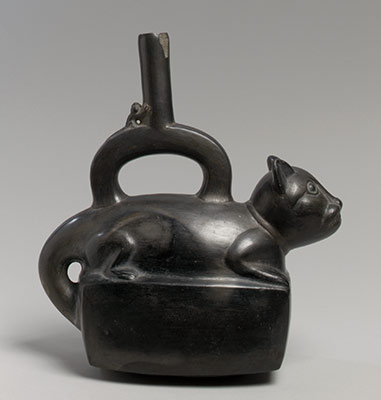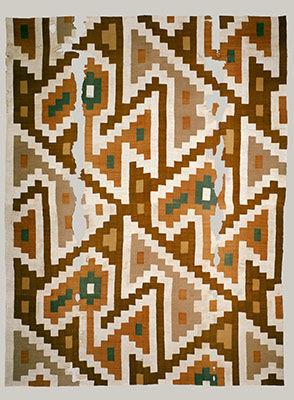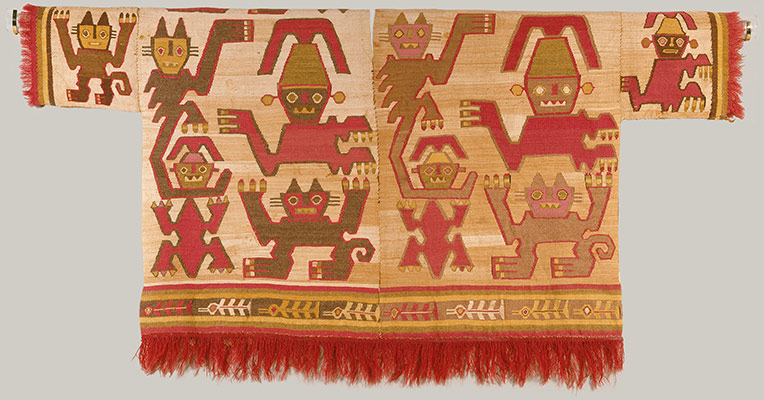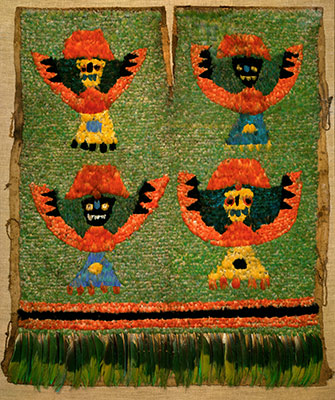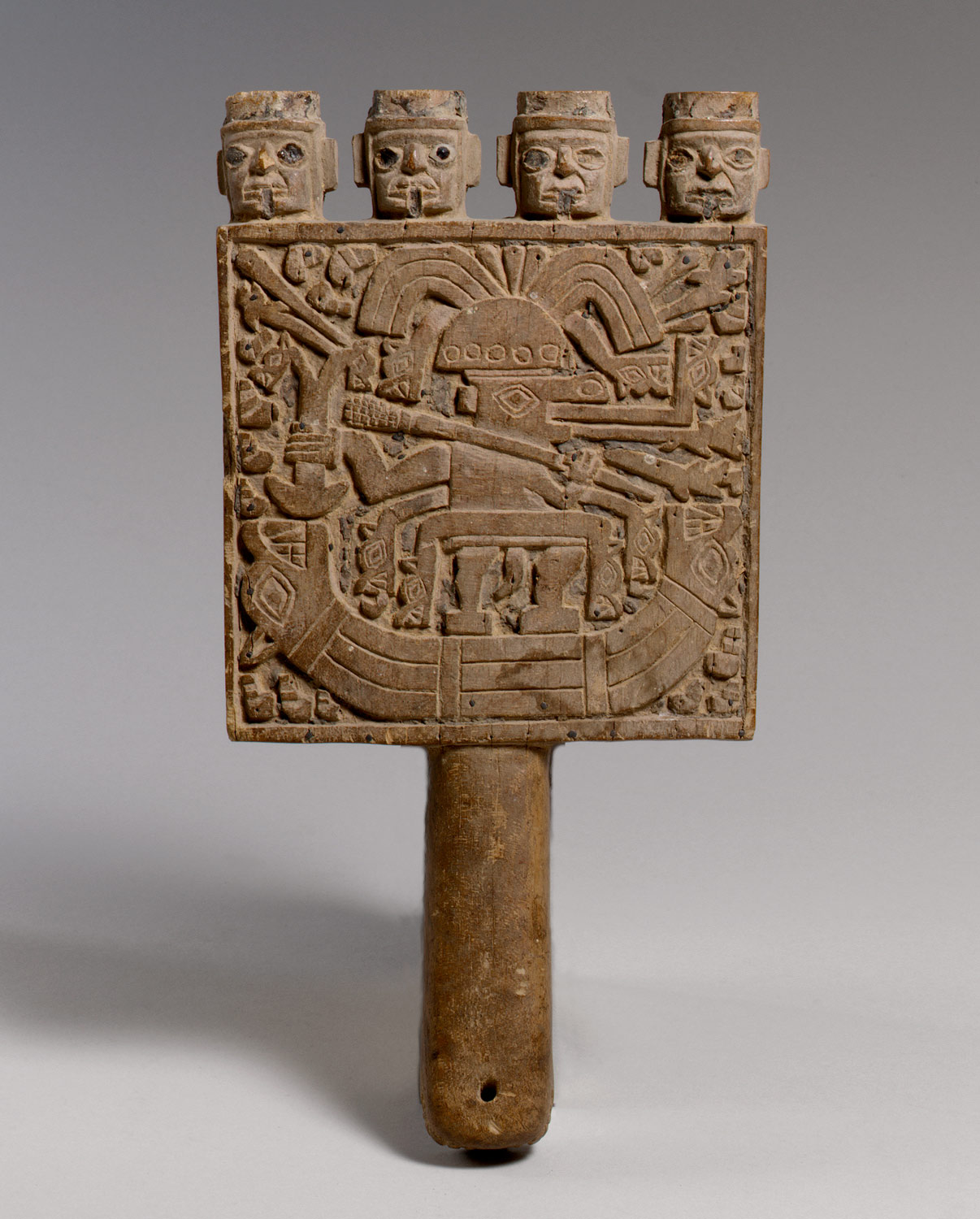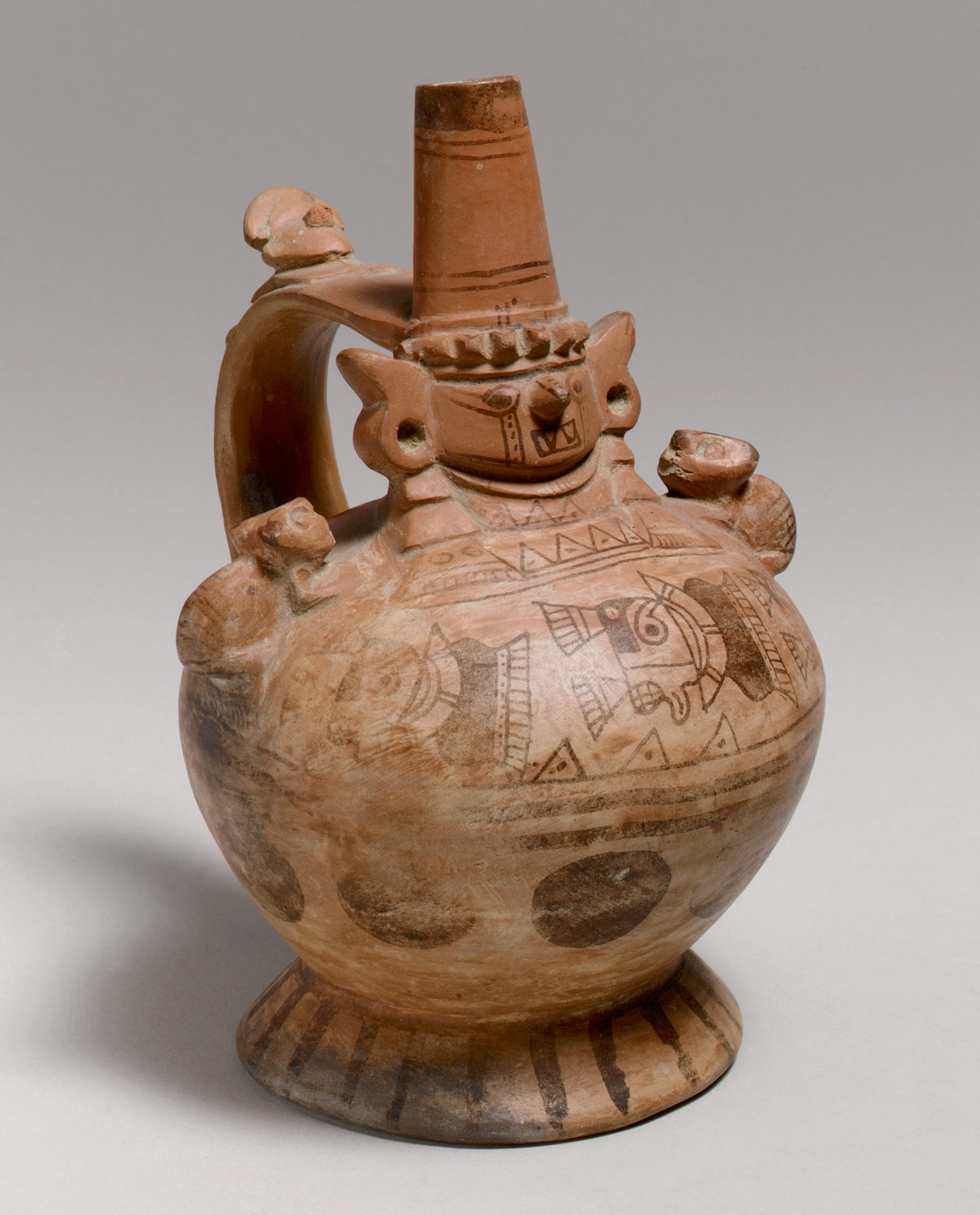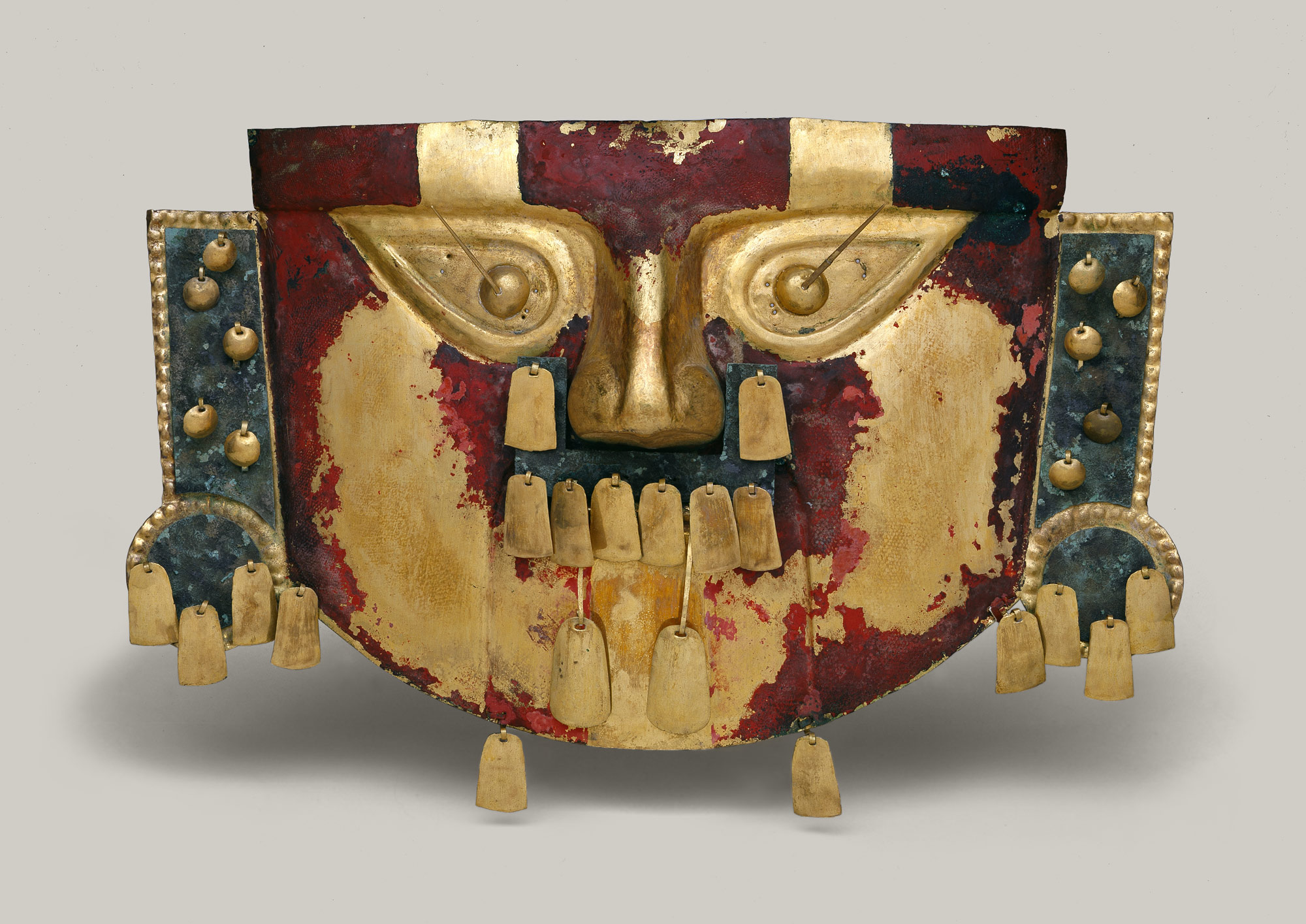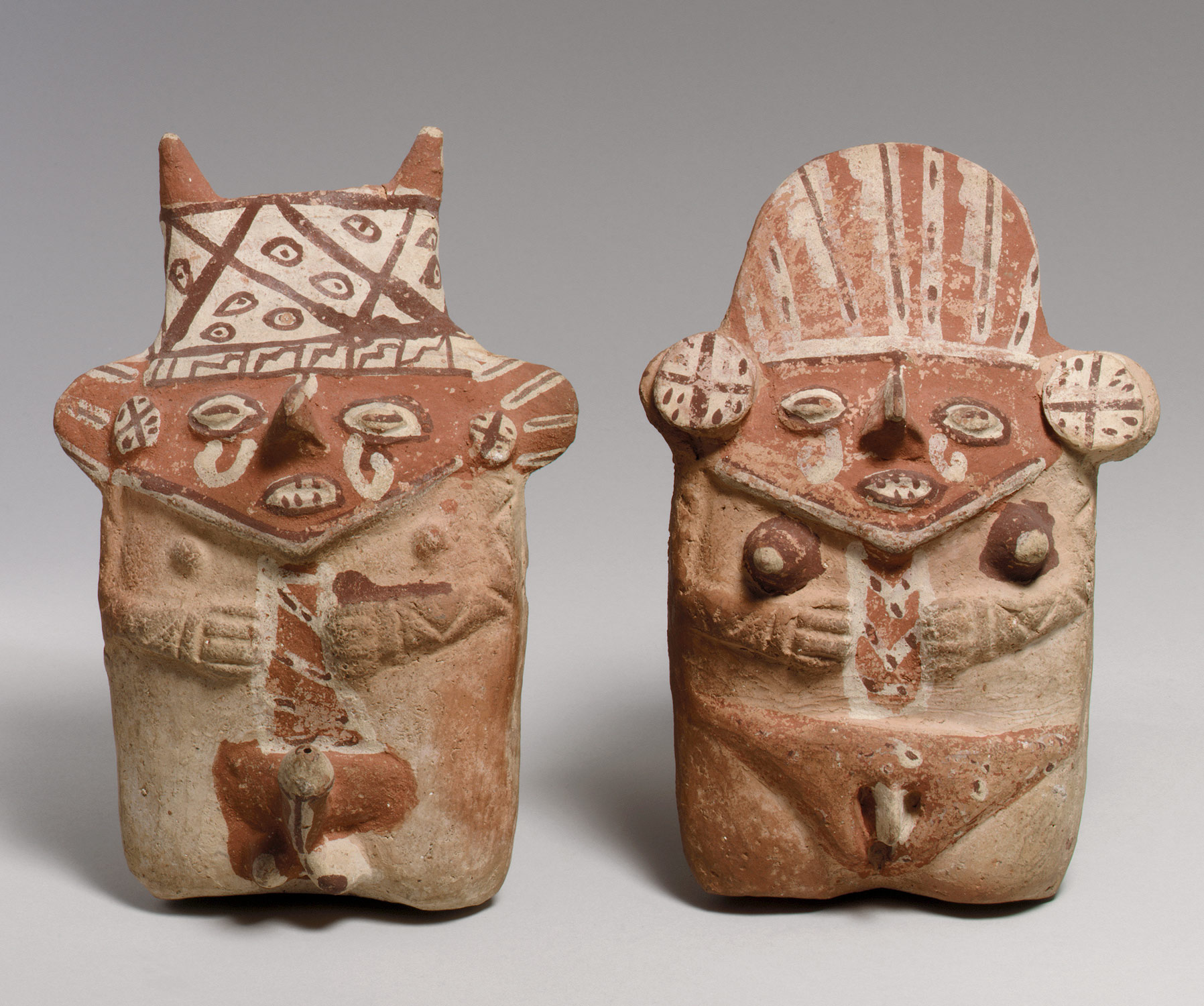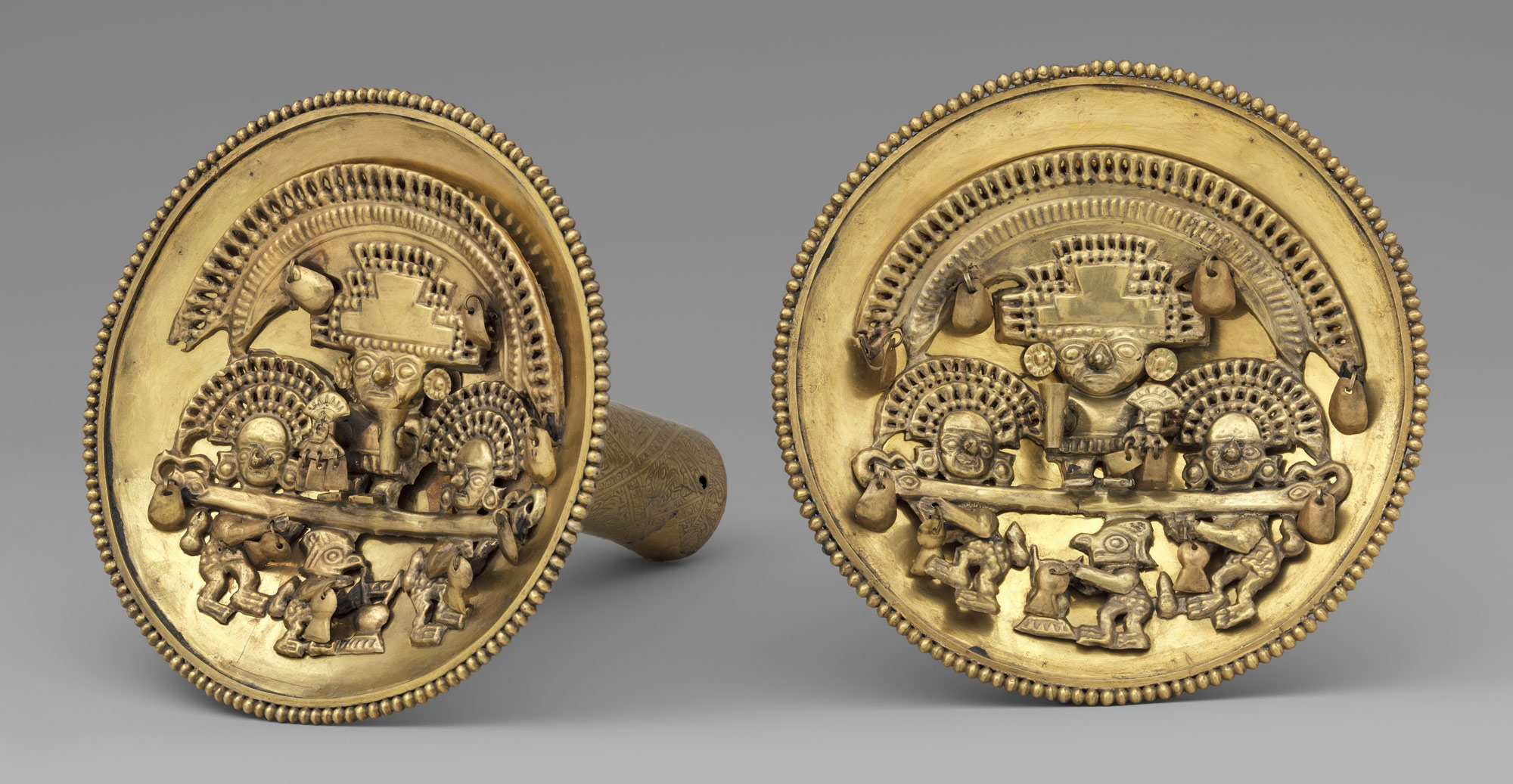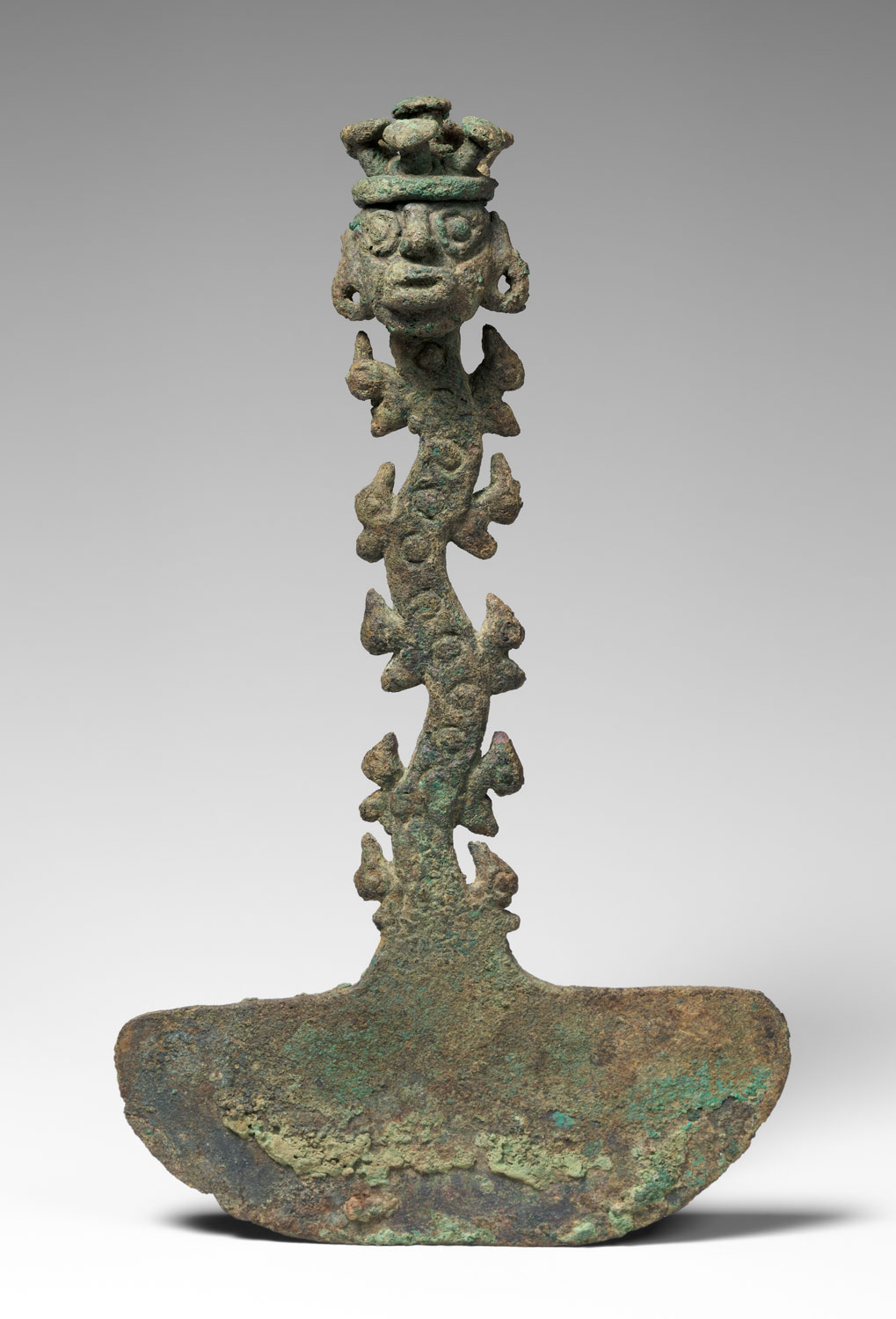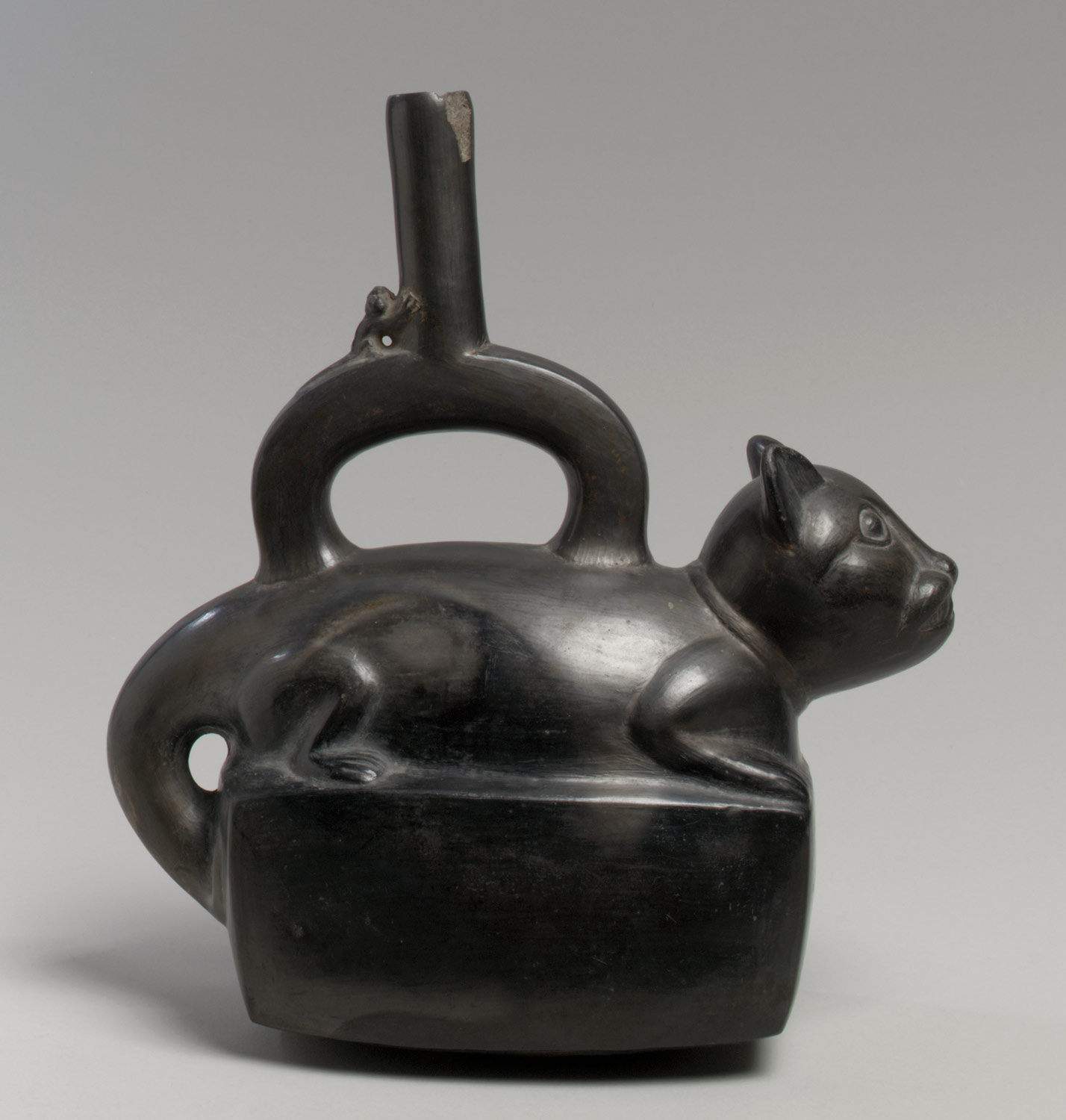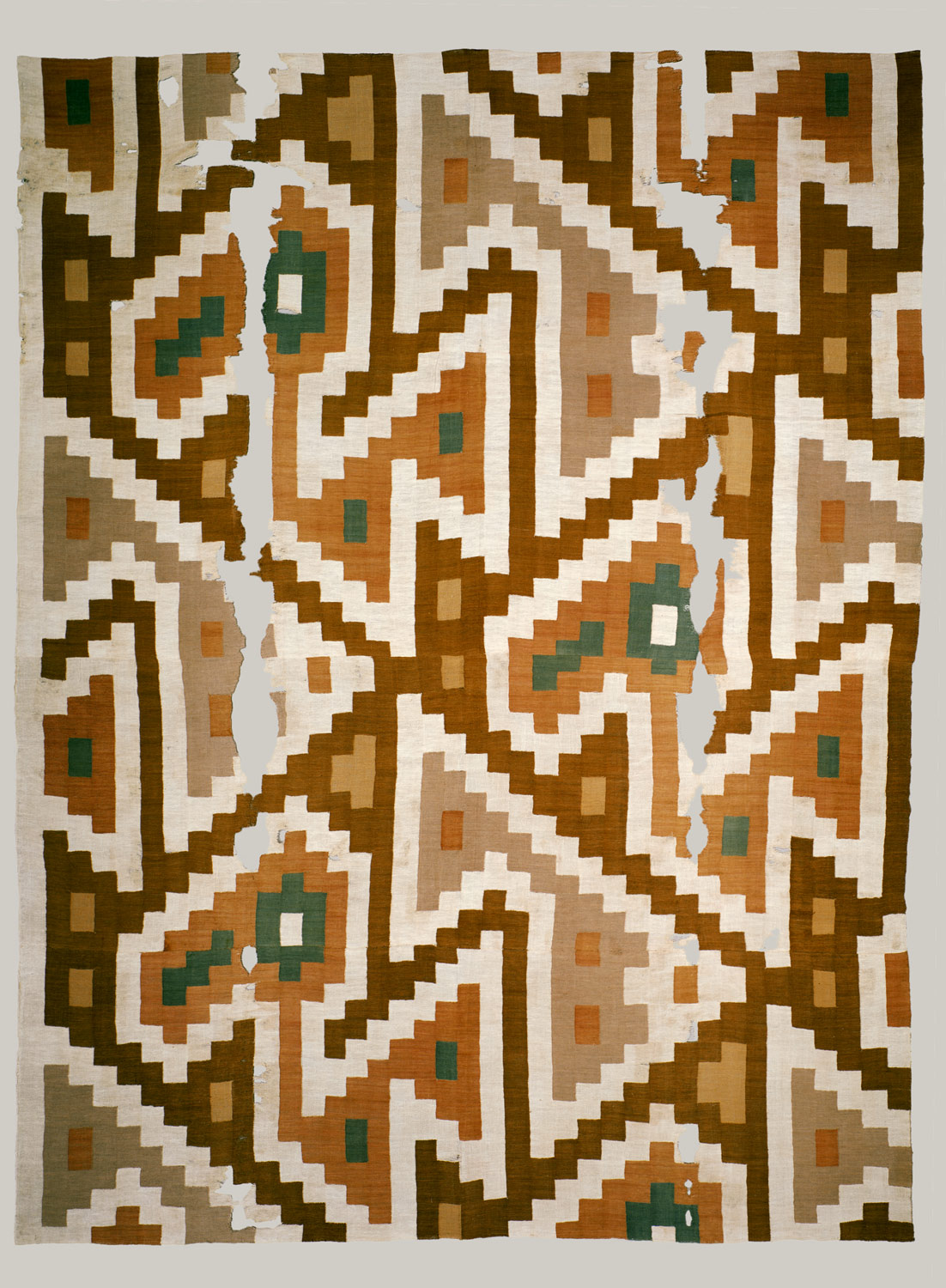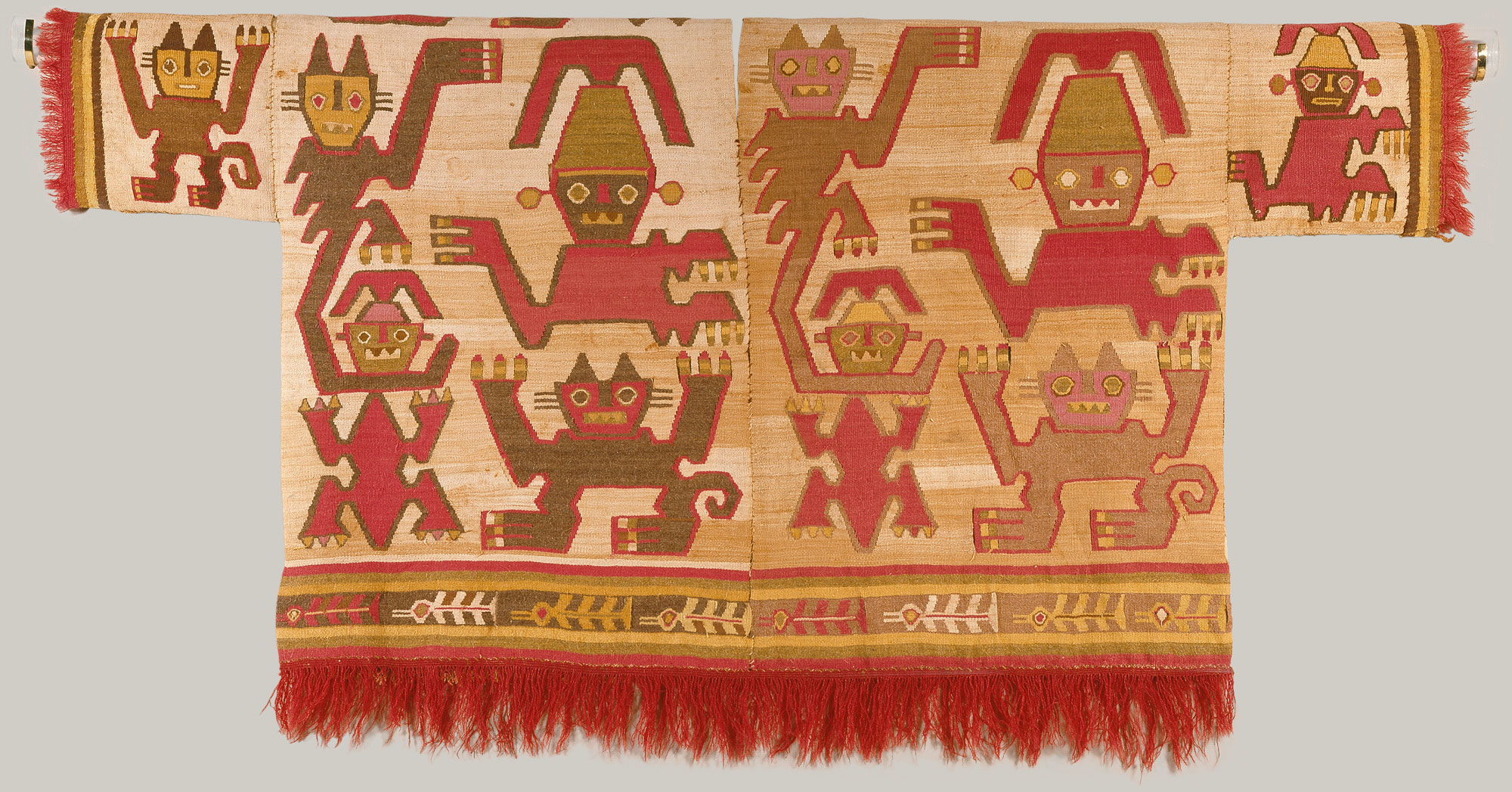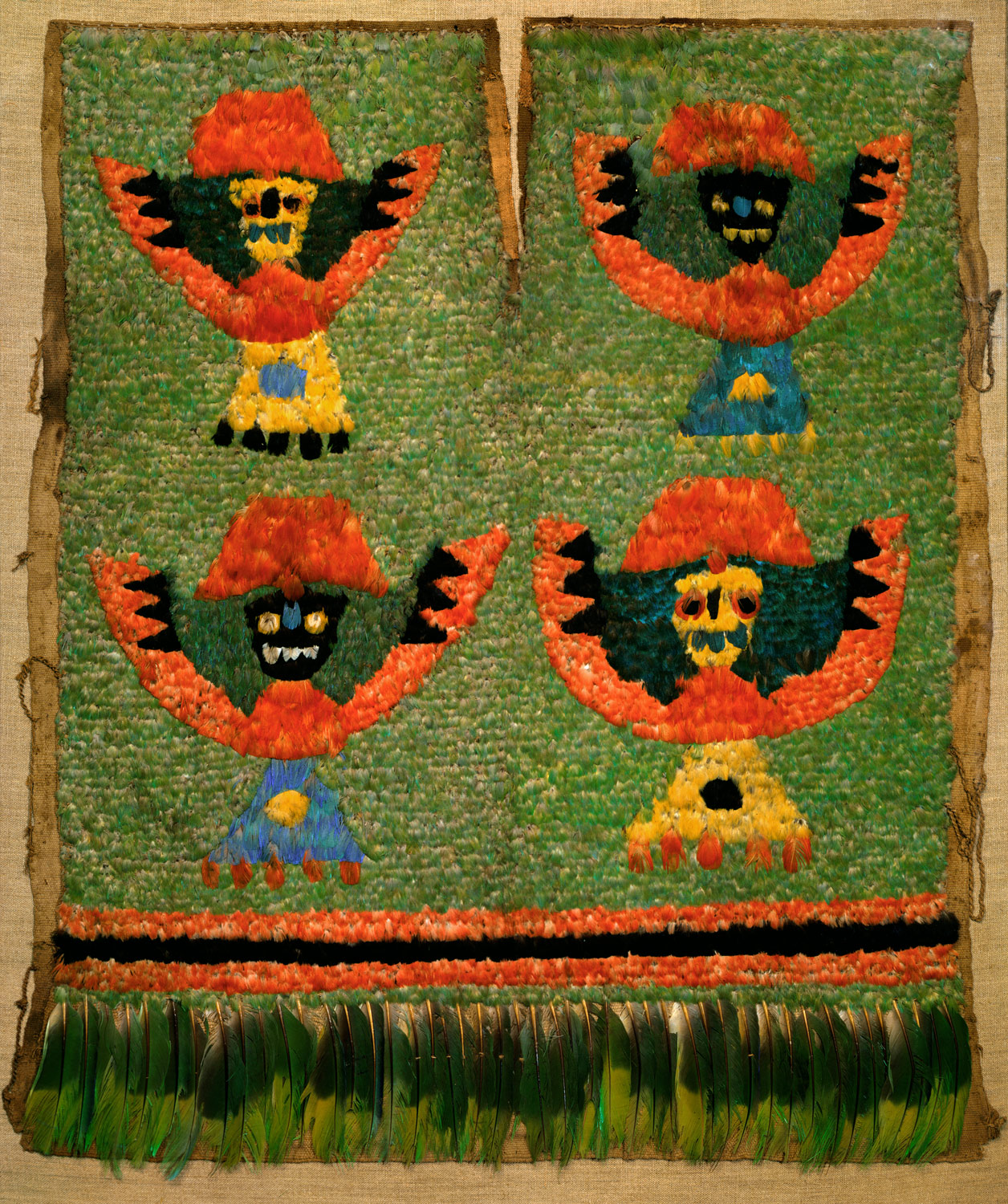With the decline of Wari and Tiwanaku, political power and cultural initiatives shift from the highlands to the coastal desert. The north coast of Peru, which has abundant water supply for irrigation, is the center of development and sees the rise of the powerful Chimú state. Small and mid-sized kingdoms control the valleys of the central and southern coasts. In the highlands, many groups, large and small, do not attain the same political complexity. No territorial expansion occurs, nor is monumental architecture built. Despite political fragmentation, many groups have similar societal goals and approaches to art. There is increased emphasis on secularism and accumulation of wealth. In the arts, a trend toward standardization and repetitiveness dominates; subject matter is limited. Coastal peoples focus on sea-related motifs, geometric designs, and a stylized frontal human figure.
Central and Southern Andes, 1000–1400 A.D.
Timeline
1000 A.D.
1100 A.D.
HIGHLANDS
COASTAL LOWLANDS
1100 A.D.
1200 A.D.
HIGHLANDS
COASTAL LOWLANDS
1200 A.D.
1300 A.D.
HIGHLANDS
COASTAL LOWLANDS
1300 A.D.
1400 A.D.
HIGHLANDS
COASTAL LOWLANDS
Overview
Key Events
-
ca. 1000
The northern Sicán culture of Peru is at its height. Ceramics, textiles, metal objects, and painted murals bear the image of the so-called Sicán Lord. Perhaps the depiction of Naymlap, the legendary founder of the Sicán dynasty, it might also be the main Sicán deity.
-
ca. 1000
In northwestern Argentina, handsome ceramic urns are used for the burial of children. Typical Belén and Santa María urns have small, flat bases, bulging bodies with attached strap handles, and high, flared collars. Abstract human faces are painted on the urns in black on red or black on yellow. The faces are surrounded by geometric motifs, stylized snakes, and other animals.
-
ca. 1000
In the northeastern Peruvian Andes, the Chachapoya people build settlements of up to 400 structures along ridges and mountain tops. Stone buildings are circular houses topped with conical, thatched roofs. At Gran Pajatén, some structures are decorated with intricate stone mosaic friezes depicting hawks and splayed human figures.
-
ca. 1050
Thin, I-shaped blades of arsenical copper alloy, called naipes, are neatly stacked in burials from the Lambayeque region north to Ecuador. Also called ax money because of their shape, naipes are standardized to at least five different sizes. They are perhaps used by specialized traders as a medium of exchange.
-
ca. 1100
Drought begins in the Bolivian altiplano. Tiwanaku is rapidly abandoned. Numerous smaller villages in the surrounding region are settled.
-
ca. 1100
The major center at Batán Grande is burned—probably by its inhabitants—and abandoned. A new ceremonial center, Túcume, is built to the west. Several large truncated adobe mounds are constructed around the mountain and natural huaca (sacred place), Cerro La Raya. Agricultural communities are near the fields, fishing villages exist along the coast.
-
ca. 1150
In the southern highlands, a number of local ceramic styles derive from earlier Tiwanaku wares. The most widespread style is Mollo. Mollo decorated vessels have geometric designs of diamonds, rectangles, and crosshatching arranged in linear patterns in dull black and yellow-white on red.
-
ca. 1150
La Centinela in the Chincha Valley on the southern coast is the capital of a small, wealthy kingdom. Large adobe compounds feature tiered pyramids decorated with adobe friezes and sizable forecourts for public activities. Straight roads link the city to numerous sites in the valley with similar architecture.
-
ca. 1200
Pachacamac continues as an important religious center. Control of earthquakes may be among the responsibilities of the principal deity worshipped here. The Ichma peoples of the Lurín and Rímac valleys add monumental pyramids with access ramps to earlier structures at the site.
-
ca. 1200
The architecture at Chokepukio, about twenty miles east of Cuzco, features several monumental halls with wall niches similar to constructions found at earlier Wari sites. The buildings may relate to ancestor worship.
-
ca. 1200
The Chimú kingdom begins to expand north from the capital Chan Chan in the Moche Valley. They establish administrative centers in conquered valleys such as Farfán in the Jequetepeque Valley. Six walled, monumental adobe compounds recall similar structures at Chan Chan.
-
ca. 1250
On the central coast, the Chancay peoples produce striking ceramics painted a brown-black on white slip. Tall standing human figures, often in male and female pairs, with short outstretched arms are abundant, as are large ovoid jars. The generally unburnished, gritty surfaces and often hastily applied slips lend the works a spontaneous, engaging quality.
-
ca. 1250
Small oases towns of the San Pedro de Atacama–Loa River drainage in central Chile are inhabited by Atacameño peoples. At Lasana, dwellings consist of conjoined, irregularly arranged apartment-like rooms surrounded by walls for defense. Buried in cist graves beneath house floors are tombs with goods that include wooden snuff tablets, carved bone snuff spoons, spindle whorls, and weaving implements.
-
ca. 1250
Chan Chan continues to grow. Made up of several monumental ciudadelas (walled palace compounds), which function as royal residences, administrative centers, storehouses for royal wealth, and mausolea for deceased monarchs, it is not a true city. Many of the interior walls are embellished with polychrome adobe reliefs.
-
ca. 1250
The Wanka peoples occupy the upper Mantaro basin near the city of Jauja in the central highlands. The largest settlement is Tunanmarca, which may have as many as 10,000 inhabitants. Surrounded by a defensive wall, the city has stone houses for the elite and commoners, but lacks public and ceremonial architecture.
-
ca. 1250
Hundreds of silver-plated copper miniatures are deposited at the Templo de la Piedra Sagrada (Temple of the Sacred Stone) in Túcume. Made of cut sheet metal, the objects range from depictions of local fauna and flora to musical instruments, to ornaments and utilitarian items such as vessels, weapons, oars, and litters.
-
ca. 1300
Northeast of Lake Titicaca, Iskanwaya in the middle Llika River Valley is an important Mollo site. On rugged terrain with a precipitous slope, the planned city covers about thirty-two acres. Built of local shale on platforms and terraces, its structures have windows and interior niches. Some are plastered and painted with red ocher. Large cut slabs are used for lintels and door jambs.
-
ca. 1300
Ica-style ceramics are widely distributed from Chincha to the Yauca Valley in the south. Among the many pleasing forms are strap-handled and drum-shaped jars and a great variety of bowls. Typically they are decorated with broad horizontal bands with small repeats of triangles, dots, squares, steps, and crosshatching in white, black, and purple on well-burnished red slip.
-
ca. 1300
In a second wave of conquests, the Chimú bring the Lambayeque area under their control; Lambayeque has been an important center for mining and metallurgy since early Moche—if not Chavín—times. The most skilled local metalsmiths are taken to Chan Chan to work for the Chimú elite.
-
ca. 1300
In the Lucre basin, southeast of Cuzco, polychrome ceramic bowls, portrait jars, and tumblers, called keros, show strong Wari influence in form and design. They may be used in feasting.
-
ca. 1300
The Diaguita peoples, on Chile’s north-central coast, embellish their handsome ceramics with expertly drawn small-scale geometric motifs in red and black on white slip arranged in a great many combinations. Typical forms are straight-sided bowls with round bottoms and shoe-shaped jars with bird- or human-headed bridge-and-spout handles.
-
ca. 1325
Craft production flourishes at Chan Chan. Well-trained specialists excel in the textile arts and metalworking. Ceramics, clearly derived from earlier Moche traditions, are predominantly blackware, and made in molds in large quantities.
-
ca. 1350
The Lupaca and Qolla peoples prosper in the Lake Titicaca area. They amass great wealth, particularly in herds of llama and alpaca, which can reach more than 80,000 animals. Living in hilltop habitation sites surrounded by walls, they bury their dead above ground in towers, called chullpas.
-
ca. 1350
The Cuzco region of the south-central highlands is inhabited by Quechua-speaking ethnic groups. A widely distributed pre-Inca ceramic style, known as Killke, features shallow bowls, jars with or without handles, and straight-sided drinking cups with slightly flared lips. The decoration in black and shades of red on buff is generally geometric, consisting of narrow lines, thicker bands, dots, triangles, diamonds, and crosshatching.
-
ca. 1380
In the Lauca Valley in western Bolivia, rectangular burial towers (chullpas) are constructed of adobe brick. They can stand over fifteen feet tall. Their outer walls are smoothed with mud plaster and painted with polychrome geometric designs—stepped diamonds, zigzag lines, squares—that recall textile patterns of the period.
-
ca. 1400
The kingdom of Chimor extends over 800 miles of coast, from the present-day Ecuadorian border to the Chillón Valley north of Lima. It controls the management of irrigation networks for agriculture and the production and distribution of luxury goods.
Citation
“Central and Southern Andes, 1000–1400 A.D.” In Heilbrunn Timeline of Art History. New York: The Metropolitan Museum of Art, 2000–. http://www.metmuseum.org/toah/ht/?period=07®ion=sac (October 2006)
Related
Map
